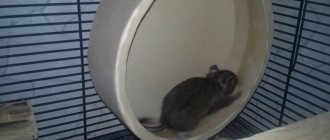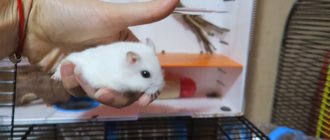- home
- General information
06.04.2018
In their natural habitat, hamsters cover enormous distances in a day. To ensure that the health of the animal at home does not suffer due to lack or lack of physical activity, it is necessary to provide them with a spacious cage and a running wheel. However, in some cases, the hamster stubbornly ignores this simulator, without showing the slightest interest in it. Why doesn't a hamster run on a wheel? Let's try to find out the reasons for this behavior and find out how you can influence the animal.
Why does a hamster need a wheel?
A running wheel is a common and, according to some owners, a mandatory accessory to a hamster cage. The wheel allows the hamster to compensate for the need for exercise, even when living in a small cage.
Wild relatives of hamsters can walk 3–5 km in one night. Hamsters do not walk; they run most of the night, constantly changing their trajectory. No matter how large the cage is, no matter how much attention you pay to your pet, it is simply impossible to provide your hamster with such serious physical activity without additional accessories.
The wheel allows the hamster to run a sufficient distance without leaving the home and without spending a lot of time. Zoologists conducted research, the results of which were stunning. Adult females and males from the control group ran 7–8 km in one night. The increase in distance is due to the fact that domestic hamsters receive a complete diet and do not have the need to look for food; they can simply run and enjoy the exercise.
This is interesting! Hamsters that have the ability to run on a wheel are less likely to damage the cage and accessories in it, since they direct their energy in a peaceful direction.
Running is a physiological necessity for a hamster, allowing it to maintain healthy weight and muscle tone. With obesity, the heart muscle suffers first. It is for this reason that hamsters die earlier than their “sporting” counterparts.
Finding out the reasons for the hamster's refusal
There are only two possible reasons for refusal:
- The age and health of the pet do not allow using the simulator.
- An animal does not run in a wheel because it is uncomfortable or does not like using it.
The first reason is simple. In the first two years of life, hamsters are very active. With age, animals become more clumsy and slow. If your pet is already old, do not force him to exercise. In any case, check your furry's health: deterioration in health often leads to decreased mobility and loss of interest in what is happening.
If the age and health of the hamster suggest a high level of physical activity, but there is no interest in the running wheel, the following reasons are possible.
- The simulator just recently appeared. Give your animal time to learn a new item.
- If after a few days your hamster is still not interested in the exercise machine, he may not be comfortable getting on it. Make sure that he can get on and off the wheel without any hindrance, and that his path is not blocked by a feeder, house, ladder or anything else. Remove objects that may block access to the accessory.
- Check the mounting level of the machine. Ideal location at floor level on the first floor of the cage. A higher position may be uncomfortable for the hamster.
- The wrong running wheel size is selected. For large hamsters, the optimal diameter is at least 18 cm, for Djungarian hamsters - at least 12, preferably 15-16 cm. If the wheel is small, it is uncomfortable for the animal to run in it; if it is too large, it is difficult for the baby to spin it, and the back may get tired.
- Check the reliability of the structure. Rocking and loud noises when using it can scare away the hamster for a long time. If the wheel squeaks, try lubricating the axle.
- Don't buy spoked or lattice wheels. Such simulators can easily injure a hamster’s paw, discouraging the desire to approach a dangerous object for a long time. The ideal option is a solid wheel. Pay attention to the material from which the exercise machine is made. Some animals prefer metal structures, others prefer plastic.
If all the conditions are met, but there is no result, try teaching your hamster to run in a wheel. Perhaps he simply did not understand what the new accessory was for.
Why doesn't the hamster come to the wheel?
Have you bought a running wheel but your hamster completely ignores it? What could be the reasons?
Why does the hamster not come to the wheel:
- Size. Adult hamsters may ignore the wheel if its diameter is less than 16.5 cm.
- Unstable fastenings. The wheel should stand firmly and not loosen while running. If the wheel drum moves horizontally, the hamster feels insecure.
- Noise. Metal wheels, especially those that were purchased a long time ago, begin to make a lot of noise. Loud noises can be frightening to a hamster.
- Foreign smell. A hamster may ignore a new accessory if it is made of low-quality plastic and has an unpleasant odor. It is important to understand that a hamster’s sense of smell is much more acute than that of a human, so the owner may not be able to detect an unpleasant odor. An alarming odor may come from paint or grease on a metal wheel.
Important! If your hamster begins to ignore exercise, there is a high probability that he is not feeling well.
By refusing to run in a wheel, the pet shows that it is saving energy. If, while refusing to run in the wheel, you observe: deterioration in the condition of the coat, loss of appetite or general activity, immediately contact your veterinarian.
Step-by-step instructions: how to make a labyrinth?
From plastic bottles
Now we’ll learn how to make a maze for a hamster with your own hands from plastic bottles. As it turns out, they can be used to make a whole gallery of multi-level tunnels. The configuration of the labyrinth can be simple, or with dead ends, and even multi-level. For the simplest play structure with 2 knees you will need 3 plastic bottles. Conventionally, they can be designated as:
- Entrance corridor.
- Passage corridor.
- Dead end.
You need to wash the bottles and remove the stickers from them. Cut off the bottom of the inlet bottle. Through this hole the hamster will enter the maze from his cage. The cut line should be free of notches and burrs. Cover the cut with electrical tape or tape so that the sharp edges do not injure the nimble animal.
In the part of the bottle where the narrowing towards the neck begins, 2 holes are cut out opposite each other with scissors: a small hole with a diameter slightly larger than the cap and a large one, almost equal to the diameter of the bottle. To cut a circle, first use a knife to make a cross-shaped slot into which you can easily insert scissors.
In the tapering part of the second - passage - bottle, make a round hole smaller than the diameter of the bottle. Cover the edges of all cuts with tape or tape.
Insert a pass-through bottle through the large hole so that the cap comes out the other side. The parts should form the letter “G” or, in other words, a knee. In the same way, neck to neck, attach the third bottle - a dead end.
If you want your hamster to have a treat at the end of the maze, make a hole at the top of the dead end where you can insert a funnel and pour treats through it for your pet. A homemade funnel can be the cut off neck of a bottle with the cap unscrewed. The connections of the parts are firmly fixed with tape.
From cardboard
The labyrinth is made from cardboard in the same way as from planks. The parts of the product are cut out with scissors and attached to the base with tape.
Shoe boxes, toothpaste boxes, etc. are used to make interior walls. Place them inside a large base, cut random passages of an interesting configuration in the walls. Glue with glue or tape.
From toilet paper rolls or paper towels
Rolls of toilet paper and paper towels make interesting tunnels. Such tunnels are located between boxes inside the structure, making it more similar to a hamster's home in a natural environment. Paper sleeves are attached with tape or glue.
From a children's construction set
You can make a labyrinth of any complexity using a children's construction set. Build a playground with bridges, galleries and obstacles. Add a staircase and a second floor. Don't forget to design a compartment where your pet will have a treat.
From plumbing pipes
Plumbing pipes can be used both as separate tunnels inside the box and as material for the manufacture of an entire structure. This is a durable material that even has factory connections - fittings. Make a structure of any complexity from pipes. Make small holes for ventilation in the product.
Therefore, ventilation can be made in the form of longitudinal slits or a series of small holes in the pipes. This way you will have windows for observing the little traveler.
A ready-made hamster cage with a labyrinth will save you from the need to regularly walk your pet. Such products are sold in stores, or equip the cage yourself with a tunnel made of durable material. Please note that a hamster is capable of chewing even the most durable plastic of factory products. Therefore, regularly check the integrity of the structure.
We accustom the rodent to active activities
To train an animal, you can use the following trick. Place your pet's favorite treat on the trainer. To pick up the tasty treat, he will climb inside. Each time, place the treat higher and higher, then the animal will have to reach for it, and it will begin to spin the wheel. Over time, the hamster will learn to use it correctly. And don’t forget to reward the fluffy for every successful attempt.
If you fail to train the animal, try making the hamster run in a wheel. Lure the animal inside (to do this, put something tasty there) and cover the exit with cardboard or plywood. While exploring the available space, the baby will begin to rotate the simulator. And if it is suitable for your pet, then after several attempts the hamster will begin to independently climb into the structure and engage in “fitness”. Most rodents enjoy this activity. You can also initially help the animal by gently starting to spin the wheel. This way he will quickly understand what's what. In any case, be patient and give the animal time to get comfortable.
Why does a hamster refuse to run?
The main reasons why the animal does not run on a wheel are as follows:
- The design is unreliable. It is worth conducting a thorough inspection of the simulator and making sure that it is correctly mounted, assembled securely and the device is stable. If the structure is shaky, it must be secured firmly and securely. If there are large gaps between the steps, you need to lay a circular track made of cardboard on the running surface, which will prevent the furry runner's paws from falling through and getting stuck between the rungs and will protect him.
- The location of the structure is inconvenient. The height of the placement should correspond to the height of the animal so that it is convenient for the hamster to climb inside the structure. It is important to make sure that there are no obstacles on the pet’s way to the simulator - if the animal is in the way of bowls or a resting house, then they need to be moved so that access to the simulator is free.
- The size of the simulator does not correspond to the dimensions of the rodent. The diameter of the wheel should allow the animal to move freely inside the simulator. If the diameter is too small in relation to the dimensions of the hamster, then the animal will be cramped inside such a structure. The diameter of the running circle for a dwarf hamster should be from 12 cm, and for a Syrian hamster – from 18 cm.
- The hamster does not like the material of the trainer. There are no recommendations for this case - preferences depend on the individual. Some hamsters love products made of plastic, others - metal.
- The device makes a lot of noise when rotating. The loud squeak that a metal running wheel can make frightens the animal and depresses it. For silent rotation, you need to lightly lubricate the mechanism with vegetable oil.
- There is a risk of injury. If the design is not well thought out or does not suit the animal, it may get injured when using the simulator. A hamster that hits itself or has its paw pinched will lose the desire to use the dangerous exercise machine. If the design cannot be adjusted, the simulator will have to be replaced.
- The rodent is weakened due to illness or advanced age. For these reasons, you should not force your pet to train, lure him into the wheel with treats, etc.
Conclusion
To train a hamster on a running wheel, you need to choose an accessory that suits your pet. Proper selection and installation increases the chances that the animal will use it. However, even this does not guarantee success. A hamster's refusal to turn the wheel is a rare phenomenon, but it does occur. If, despite the efforts of the owners, the animal ignores the running wheel, provide the pet with physical activity using a walking ball. Be attentive to your little furry, then you will be able to understand what he needs for a full and healthy life.











